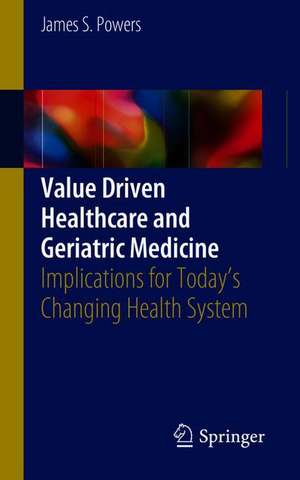Value Driven Healthcare and Geriatric Medicine: Implications for Today's Changing Health System: Bestsellers și noutăți cărți Geriatrie
Autor James S. Powersen Limba Engleză Paperback – 16 mai 2018
Geriatric patients consume a disproportionate share of healthcare resources, so CMS directs Medicare and drives geriatric healthcare models. All other insurers generally model CMS/Medicare guidelines. Innovative geriatric care models which demonstrate improved outcomes and cost moderation are scaled and lessons learned used to create new healthcare models. The best data for broader value driven healthcare comes from the geriatric models, which currently have the best data available.
This book traces the origins of value-based purchasing and current geriatric care models and synthesizes their implications for today's changing health system. It also discusses healthcare accountability and risk sharing. The audience includes geriatric healthcare professionals, but also a wider audience interested in broader healthcare models and value driven healthcare from a policy, economic, and ethical perspective. These include primary care physicians, specialists who work with aging patients, hospital administrators, healthcare educators, healthcare organizations, and all medical professionals working with aging patients and patients affected by healthcare reform.
Preț: 447.81 lei
Preț vechi: 471.39 lei
-5% Nou
85.69€ • 90.11$ • 70.80£
Carte tipărită la comandă
Livrare economică 14-19 aprilie
Specificații
ISBN-10: 331977056X
Pagini: 150
Ilustrații: XI, 156 p. 19 illus., 17 illus. in color.
Dimensiuni: 127 x 203 x 20 mm
Greutate: 0.18 kg
Ediția:1st ed. 2018
Editura: Springer International Publishing
Colecția Springer
Seria Bestsellers și noutăți cărți Geriatrie
Locul publicării:Cham, Switzerland
Cuprins
1. Introduction – The Legacy of the Affordable Care Act · US healthcare spending, categories, regional variability, comparison to other countries
· Growth of healthcare spending 1960-2010 and history of policy efforts to contain spending growth
· Aims of the Affordable Care Act: Improve access, Improved quality, Slow the rate of healthcare cost increase
· Outcomes of the Affordable Care Act: 20 million more individuals insured, enhanced uniform healthcare coverage requirements, improvement of the Medicare Health Insurance Trust Fund reserves, Healthcare inflation flat 2010-2015 · Definition of value-based healthcare purchasing
2. Quality Indicators, Outcomes, and Performance Pay
· History of policy efforts to enhance healthcare quality
· Nursing homes and long-term care, STAR ratings, Nursing Home Compare · Hospitals, DRG’s, Inpatient Quality Reporting Program, Hospital Compare, Medicare Annual Payment Updates
· Home and community-based services, Home Health Compare
· Physician PQRS and MACRA
3. Are the Drivers of Healthcare Change Changing Healthcare Outcomes?
· Standardization and reporting versus quality improvement
· Measures of success: Better health care (IOM 6 domains), Access (preventive care, population health), Slow the rate of healthcare inflation · High value care
· Quality reporting requirements
· Transfer of healthcare costs and risk to insurance, corporations, individuals
4. Value-Based Healthcare Purchasing
· Transparency and accountability in healthcare
· Variability in cost and utilization
· High value care recommendations
5. New Models of Healthcare Delivery · Trajectory of healthcare models, cost, risk, population impact
· Bundled payments models
· Single and to detailed risk for healthcare organizations
· Capitated models
· Disease state innovations
· Transitions of care programs (hospital initiated post discharge interventions, joint accountability for hospitals home health agencies long-term care facilities)
· Hospital at home
· Telehealth and coordinated transitions of care
6. Educating New Healthcare Providers for the 21st Century
· Collaborative practice models
· Inter-professional teamwork
· Education regarding new healthcare models
7. The Primary Care dilemma
· Incentives for primary care
· The composition of primary care workforce
· New models of primary care delivery
8. Transitions of Care
· Value-based purchasing in the continuum of care
· Cost avoidance as a new cost center
· Systematic assessment in targeting of modifiable risk factors
9. Through the Looking Glass - Visions of the Future of Healthcare
· Global healthcare system budgeting
· Value-based purchasing and stimulation of new healthcare models
· Oversight of healthcare training
· Risk sharing and the scope of personal responsibility for healthcare
Recenzii
Notă biografică
James S. Powers, MD
Textul de pe ultima copertă
This book traces the origins of value-based purchasing and current geriatric care models to deliver value in the broader healthcare system. The text focuses on the three goals that are expected to remain at the center of healthcare: improving access to healthcare via insurance coverage, improving the patient’s experience and quality of care, and effectively managing healthcare costs. Chapters cover the quality indicators of care, drivers for improved outcomes, and models of care as seen in geriatrics as they can be expanded upon for the larger system. The text also discusses some of the most critical periods for aging patients and the ways that these lessons can inform the larger system. These topics include transitioning from the hospital to the home setting, integrating care between geriatric workers, and staff training and the clinical pearls for all changing demographics.
As the healthcare system evolves and the population ages, Value Driven Health Care proves to be a vital resource for geriatricians, primary care physicians, specialists who work with aging patients, hospital administrators, healthcare educators, healthcare organizations, and all medical professionals working with aging patients and patients affected by healthcare reform.
Caracteristici
Descriere
Value driven healthcare is the lasting legacy of the Affordable Care Act, which had three goals: to improve access to healthcare by increasing healthcare insurance coverage, to improve the patient’s experience and quality of care, and to slow the rate of increase in healthcare costs. Regardless of changes to the financing of healthcare or changes in policy, value-based purchasing for healthcare is to remain a constant feature of the healthcare horizon. Value-based purchasing is a demand side strategy to reward quality in health care delivery. Value-based purchasing involves cost considerations and includes the actions of employers, the public sector, health plans, and individual consumers in making healthcare decisions. Effective health care services and high performing health care providers are incentivized to provide quality outcomes and to control cost. Value-based purchasing drives quality metrics which are publicly reported and serve as important levers for changes in healthcare delivery.
Geriatric patients consume a disproportionate share of healthcare resources, so CMS directs Medicare and drives geriatric healthcare models. All other insurers generally model CMS/Medicare guidelines. Innovative geriatric care models which demonstrate improved outcomes and cost moderation are scaled and lessons learned used to create new healthcare models. The best data for broader value driven healthcare comes from the geriatric models, which currently have the best data available.
This book traces the origins of value-based purchasing and current geriatric care models and synthesizes their implications for today's changing health system. It also discusses healthcare accountability and risk sharing. The audience includes geriatric healthcare professionals, but also a wider audience interested in broader healthcare models and value driven healthcare from a policy, economic, and ethical perspective. These include primary care physicians, specialists who work with aging patients, hospital administrators, healthcare educators, healthcare organizations, and all medical professionals working with aging patients and patients affected by healthcare reform.







































